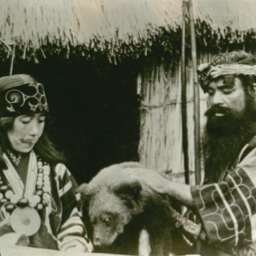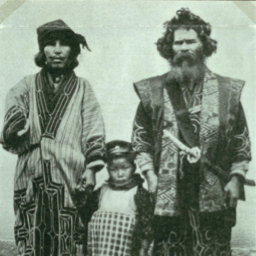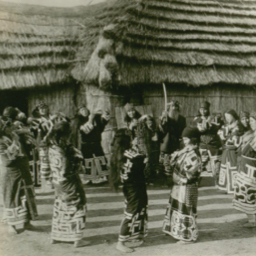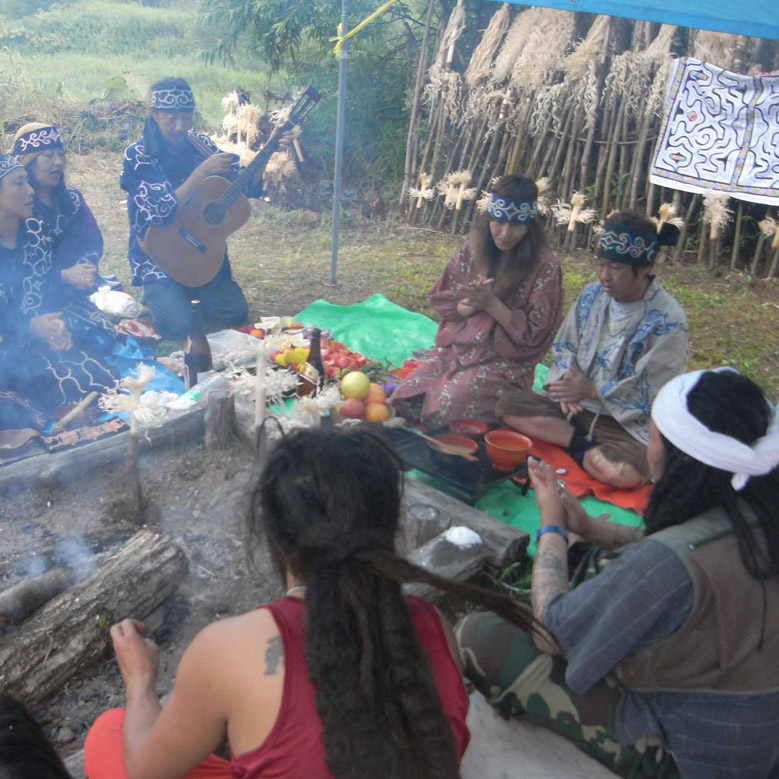4.9: Virtual Field Trip: The Ainu, Japan
- Page ID
- 82417
Virtual Field Trip: The Ainu, Japan
The indigenous people of northern Japan call themselves Ainu, meaning “people” or “humans” in their language. Recent DNA evidence suggests that the Ainu are the direct descendants of the ancient Jomon people who inhabited Japan as early as 12,000 years ago. Astonishingly, the Jomon culture existed in Japan for some 10,000 years, and today many artistic traditions of the Ainu seem to have evolved from the ancestral Jomon. As such, this artistic continuum represents one of the oldest ongoing cultural traditions in the world spanning at least ten millennia. – Lars Krutak, Tattooing Among Japan’s Ainu People
Select an image to view larger:
The practice of modifying one’s body by marking it has been present from ancient times. And the evidences of tattoo practice are scattered worldwide. Here the question arise what made people think of marking their body? Tattoo in many indigenous community is a part of their culture and it is done on men, women and sometimes on the children too, but they signify a different meaning to the different members of the society. Tattoo is often associated with spirituality, power, and gender. Therefore, to trace back the necessity of marking the body could be possibly for gaining control over something through a symbol that is tattoo and it is done on the body as body is the only thing that we own, therefore the marks that are tattooed in the body is the symbol of owning something. In tribal community tattoos are done after puberty as the symbol of being sexually matured or sometime after achieving some certain ranks in the society in case of men, and often married women are marked by tattoo as a symbol of marriage.”
-Archita Dey and Kaustav Das, Department of Anthropology University of Calcutta, from Why We Tattoo? Exploring the Motivation and Meaning
Your Field Guide
Explore the Required Websites
- Website: Ainu, Spirit of a Northern People (requires Flash)
- Video: AINU: Indigenous People of Japan, United Nations
- Website: Lars Krutak, Tattoo Anthropologist
Choose a Topic and Explore More Deeply
In addition to the required resources, choose one of these topics to dive deeper. Use these links, to learn more about your topic:
History and Culture
- Website: Ainu Museum: History and Culture
- Website: NOVA Island of the Spirits: Origins of the Ainu
- Website: NOVA: Island of the Spirits: Ainu Legends
- Article: Japan: Ainu recognized as indigenous people Global Voices
- Video: The Ainu People of Japan Older educational film of unknown origin – Ainu women talking about her people, showing customs and music
Tattoos
- Slideshow: Looking at the World’s Tattoos, Smithsonian Magazine
- Images: Indigenous Tattooing, Dion Kaszaz Galleries of Indigenous Tattoos, and tattoo practices
- Image of Married Ainu Couple. Authored by: S. Knoshita. Provided by: National Museum of Denmark- Flickr Commons. Located at: https://www.flickr.com/photos/thenationalmuseumofdenmark/10795496526/in/datetaken/. License: CC0: No Rights Reserved
- Image of Ainu Family Clichu00e9 Print. Authored by: National Museum of Denmark. Provided by: Flickr Commons. Located at: https://www.flickr.com/photos/thenationalmuseumofdenmark/10795494526/in/datetaken/. License: CC0: No Rights Reserved
- Image of Ceremonial Round Dance. Authored by: S. Kinoshita-National Museum of Denmark. Provided by: Flickr Commons. Located at: https://www.flickr.com/photos/thenationalmuseumofdenmark/10795473465/in/datetaken/. License: CC0: No Rights Reserved
- Image of Ainu Woman Mongoloid. Authored by: S. Kinoshita- National Museum of Denmark. Provided by: Flickr Commons. Located at: https://www.flickr.com/photos/thenationalmuseumofdenmark/10795473465/in/datetaken/. License: CC0: No Rights Reserved
- Image of Ainu Woman Mongoloid. Authored by: John Batchelor. Provided by: Wikimedia Commons. Located at: https://commons.wikimedia.org/wiki/File:Ainu_woman_Mongoloid.png. License: Public Domain: No Known Copyright
- Image of Ainu Man Outside His House. Authored by: Aage Henriksen- National Museum of Denmark. Provided by: Flickr Commons. Located at: https://www.flickr.com/photos/thenationalmuseumofdenmark/10795478385/in/datetaken/. License: CC0: No Rights Reserved
- Image of woman gives a traditional Ainu music instrument demonstration. Authored by: David Oomes. Provided by: Wikimedia Commons. Located at: https://commons.wikimedia.org/wiki/File:Woman_playing_traditional_Ainu_instrument.jpg. License: CC BY: Attribution
- Image of self-identified Ainu man perfomring a traditional Ainu dance at the Ainu Museum. . Authored by: japanexperterna.se. Provided by: Wikimedia Commons. Located at: https://commons.wikimedia.org/wiki/File:Ainu_man.jpg. License: CC BY: Attribution
- Image of an Ainu Marriage. Authored by: munechika tanaka. Provided by: Wikimedia Commons. Located at: https://commons.wikimedia.org/wiki/File:Ainu_Marriage_-_2.jpg. License: CC BY: Attribution
- Virtual Field Trip: The Ainu Japan. Provided by: Pima Community College. Located at: http://cc.pima.edu/~lumen/ant112/Modules/M2%20FieldTrip_Ainu.htm. License: CC BY: Attribution









